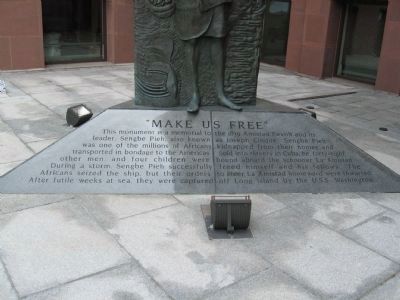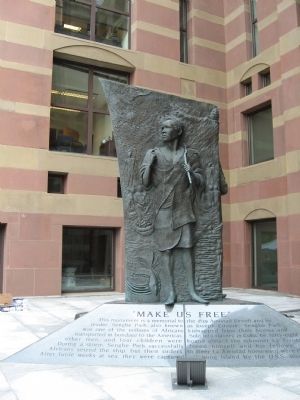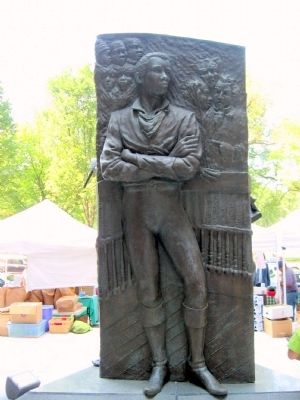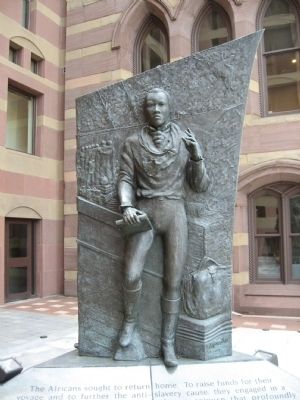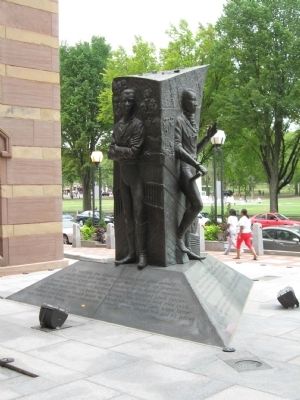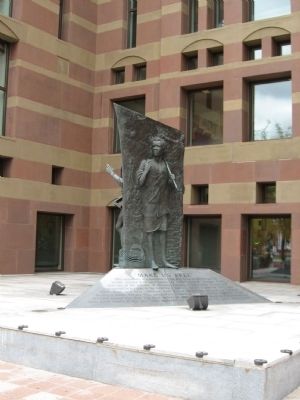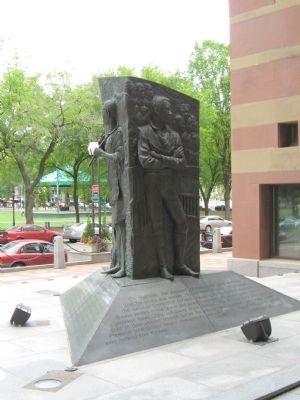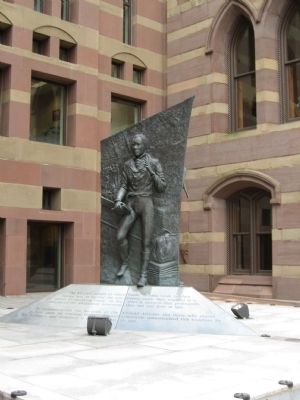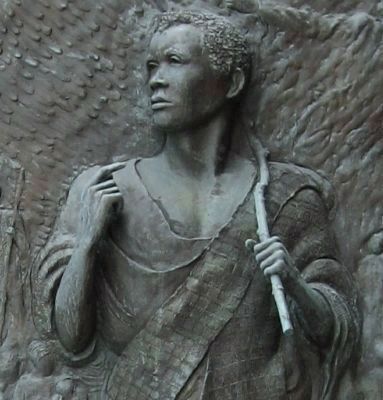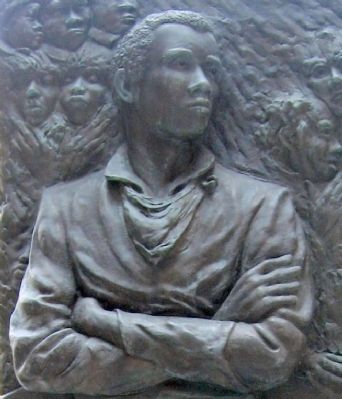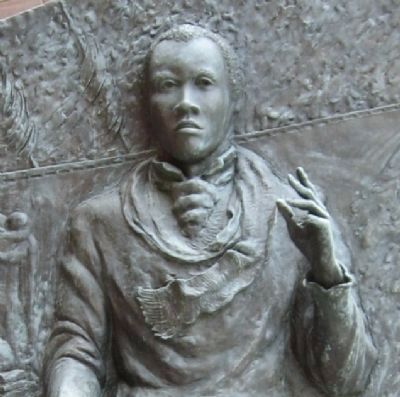Downtown in New Haven in New Haven County, Connecticut — The American Northeast (New England)
“Make Us Free”
Amistad Memorial
[ south side ]
[ east side ]
On this site, the Amistad Africans were jailed awaiting trial for piracy and murder. To aid their struggle for freedom, the Amistad Committee formed, counting in its number ministers Simeon Jocelyn, Joshua Leavitt, and James Pennington; merchant Lewis Tappan; professor Josiah Gibbs; and lawyer Roger Baldwin. The Africans were tried twice prior to their ultimate triumph before the United States Supreme Court, where former President John Quincy Adams courageously defended them. Sengbe Pieh and his fellows were declared Free Persons.
[ north side ]
The Africans sought to return home. To raise funds for their voyage and to further the anti-slavery cause, they engaged in a series of speaking tours. In 1841, after a sojourn that profoundly influenced the abolitionist movement, they set sail, free at last.
To commemorate the heroism of the Amistad Africans and those who shared in their quest for freedom, the 1989 Amistad Committee commissioned his sculpture by Ed Hamilton and dedicated it on September 26, 1992.
Erected 1992 by the 1989 Amistad Committee.
Topics and series. This historical marker is listed in these topic lists: Abolition & Underground RR • African Americans • Law Enforcement • Waterways & Vessels. In addition, it is included in the Former U.S. Presidents: #06 John Quincy Adams series list. A significant historical date for this entry is September 26, 1992.
Location. 41° 18.445′ N, 72° 55.467′ W. Marker is in New Haven, Connecticut, in New Haven County. It is in Downtown. Marker is at the intersection of Church Street and Court Street, on the right when traveling north on Church Street. Located in front of New Haven City Hall. Touch for map. Marker is at or near this postal address: 165 Church Street, New Haven CT 06510, United States of America. Touch for directions.
Other nearby markers. At least 8 other markers are within walking distance of this marker. Renovation of the New Haven Green (within shouting distance of this marker); New Haven Green (within shouting distance of this marker); New Haven Water Company (within shouting distance of this marker); New Haven (about 300 feet away, measured in a direct line); New Haven Memorial Flagpole (about 300 feet away); Mr. Richard Perry Home Site (about 300 feet away); Welcome to the New Haven Green (about 500 feet away); a different marker also named Welcome to the New Haven Green (about 500 feet away). Touch for a list and map of all markers in New Haven.
More about this marker. 1992 three-sided bronze bas-relief by Ed Hamilton is approx. 9 feet tall on a 2 foot granite base.
Also see . . . Smithsonian Institution Art Inventories Catalog Entry. “Description: A triangular sculpture consisting of three bas-relief panels which commemorate the life of Sengbe Pieh, also known as Joseph Cinque, hero of the Amistad Revolt of 1839. Each panel depicts Pieh at a significant period in his life. The first panel shows him as a free African dressed in the garments of the Mende tribe. His proper right hand is raised to his shoulder and he points with his index finger. In his proper left hand he holds a tool over his proper left shoulder. Behind him are scenes of African tribal life. A bird flies above his proper right shoulder. The second panel shows him dressed in Western attire, awaiting trial before the United States Supreme Court. His arms are crossed in defiance. The earnest faces of his fellows are visible over his proper right shoulder and the scowling glares of his accusers are visible over his proper left shoulder. The third panel shows him standing on a dock, dressed in eighteenth-century dress, ready to return to Africa as a free man. He gestures with his raised proper left hand and holds a book in his proper right hand. A suitcase rests on the ground by his proper left leg. The sculpture rests on a triangular base that is inscribed on all sides.” (Submitted on March 8, 2014.)
Credits. This page was last revised on February 10, 2023. It was originally submitted on September 7, 2010, by Michael Herrick of Southbury, Connecticut. This page has been viewed 2,086 times since then and 80 times this year. Last updated on October 17, 2011, by Michael Tiernan of Danvers, Massachusetts. It was the Marker of the Week March 9, 2014. Photos: 1, 2, 3, 4. submitted on September 7, 2010, by Michael Herrick of Southbury, Connecticut. 5, 6, 7, 8. submitted on September 10, 2010, by Michael Herrick of Southbury, Connecticut. 9, 10, 11. submitted on September 7, 2010, by Michael Herrick of Southbury, Connecticut.
